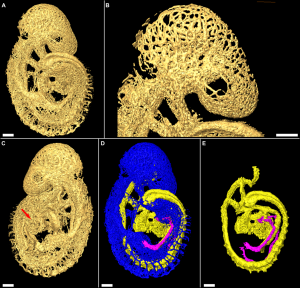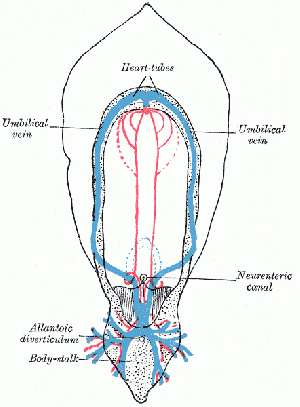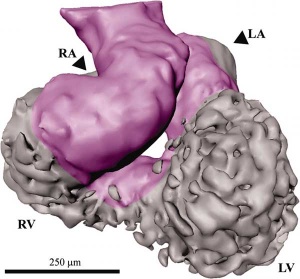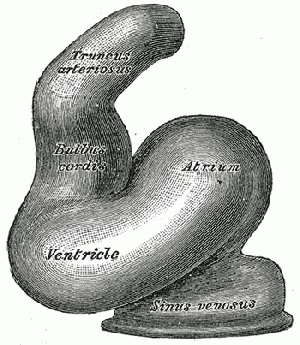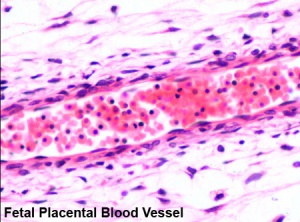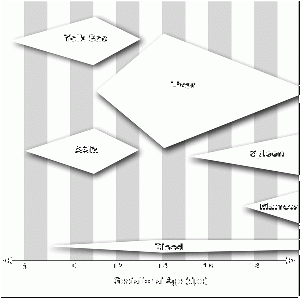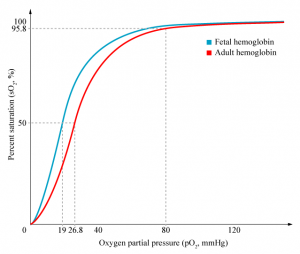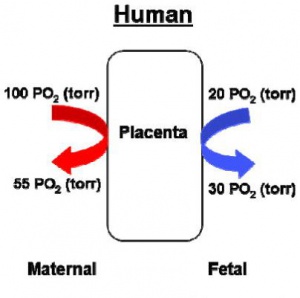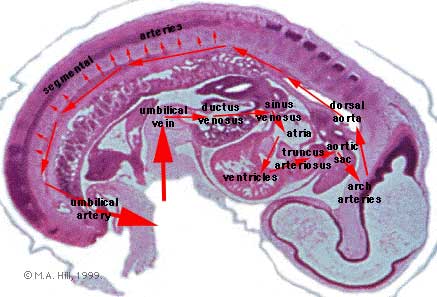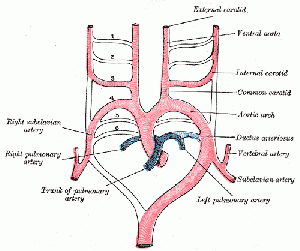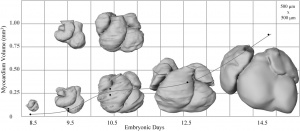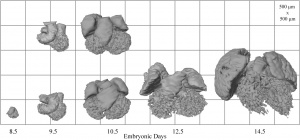Lecture - Early Vascular Development: Difference between revisions
(Created page with "{{2011ANAT2341}}") |
No edit summary |
||
| Line 1: | Line 1: | ||
{{2011ANAT2341}} | {{2011ANAT2341}} | ||
== Introduction == | |||
[[File:Mouse embryo vascular.png|300px|Mouse embryo (19 somite) vascular distribution|thumb|mage shows the mouse embryo (19 somite) vascular distribution.]] | |||
This lecture is an introduction to the events in early embryonic development that relate to mesoderm and early cardiovascular development. Texts frequently separate heart development from vascular development in order to simplify their descriptions of cardiovascular development, although the two are functionally and embryonically connected. | |||
Note that later in the course, the late development of the heart and vascular changes will be further discussed. The complexity of septation, cardiac outflow separation, remodelling of the peripheral vasculature, and the pre- to post-natal changes may also contribute to the relatively large proportion of birth defects associated with this system. These events of vascular development are covered in a later lecture. | |||
It is important to note also that we are just beginning to understand vascular development which involves the careful orchestration of a variety of moleculular mechanisms. Development does appear to be an independent mechanism preceding both skeletal and smooth muscle development and using different regulatory mechanisms (not MyoD or myogenin. In the next few years, there are certain to be new molecules identified as well as an understanding and appreciation of new roles for known molecules. | |||
==Lecture objectives== | |||
[[File:Gray0458.gif|thumb|Historic image of early human vascular development]] | |||
* Understanding of mesoderm development | |||
* Understanding of heart tube formation and early development | |||
* Understanding of early blood vessel and blood development | |||
* Brief understanding of vascular growth and regression | |||
* Brief understanding of vascular growth factors | |||
==Textbook references== | |||
* Human Embryology (3rd ed.) Larson Chapter 7 p151-188 Heart, Chapter 8 p189-228 Vasculature | |||
* The Developing Human: Clinically Oriented Embryology (6th ed.) Chapter 14: p304-349 | |||
===Other Textbooks=== | |||
* Before we Are Born (5th ed.) Moore and Persaud Chapter 12; p241-254 | |||
* Essentials of Human Embryology Larson Chapter 7 p97-122 Heart, Chapter 8 p123-146 Vasculature | |||
* Human Embryology Fitzgerald and Fitzgerald Chapter 13-17: p77-111 | |||
===Recent Reviews=== | |||
<pubmed>11891982</pubmed> | |||
<pubmed>12746463</pubmed> | |||
<pubmed>12807866</pubmed> | |||
<pubmed>11909814</pubmed> | |||
==UNSW Embryology Links== | |||
====Cardiovascular Slides==== | |||
* [[2010_Lecture_7|2009 Lecture]] | [http://embryology.med.unsw.edu.au/Science/ANAT2341lecture07.htm 2008 Lecture] | |||
====Cardiovascular Movies==== | |||
{| border='0px' | |||
|- | |||
| [[File:Heart1_looping icon.jpg|90px|link=Development_Animation_-_Heart Looping]] | |||
| [[File:Heart1_realign icon.jpg|90px|link=Development_Animation_-_Heart Realign]] | |||
| [[File:Heart1_atrium icon.jpg|90px|link=Development_Animation_-_Heart Atrial Septation]] | |||
| [[File:heart1 ventricle icon.jpg|90px|link=Development_Animation_-_Heart Outflow Septation]] | |||
|- | |||
| [[Development_Animation_-_Heart Looping|Heart Looping]] | |||
| [[Development_Animation_-_Heart Realign|Heart Realign]] | |||
| [[Development_Animation_-_Heart Atrial Septation|Heart Atrial Septation]] | |||
| [[Development_Animation_-_Heart Outflow Septation|Heart Outflow Septation]] | |||
|- | |||
|} | |||
====Cardiovascular Notes==== | |||
* [[Cardiovascular System Development]] | |||
* [[Cardiac_Embryology|Cardiac Embryology Tutorial]] - [[Basic Cardiac Embryology]] | [[Intermediate Cardiac Embryology]] [[Advanced Cardiac Embryology]] | |||
* Original Notes pages - [http://embryology.med.unsw.edu.au/Notes/heart.htm Introduction] | [http://embryology.med.unsw.edu.au/Notes/heart2.htm Abnormalities] | [http://embryology.med.unsw.edu.au/Notes/heart3.htm Stage 13/14] | [http://embryology.med.unsw.edu.au/Notes/heart4.htm Stage 22] | [http://embryology.med.unsw.edu.au/Notes/heart5.htm Stage 22 Selected Highpower] | [http://embryology.med.unsw.edu.au/Notes/heart6.htm Heart] | [http://embryology.med.unsw.edu.au/Notes/heart8.htm Heart Rate] | [http://embryology.med.unsw.edu.au/Notes/heart20.htm Blood][http://embryology.med.unsw.edu.au/Notes/heart19.htm Blood Vessels] | [http://embryology.med.unsw.edu.au/Notes/heart11.htm Molecular] | [http://embryology.med.unsw.edu.au/Notes/heart31.htm Lymphatic] | [http://embryology.med.unsw.edu.au/Child/heart.htm Postnatal] | [http://embryology.med.unsw.edu.au/history/page2b.htm#Harvey History - Harvey] | |||
==Development overview== | |||
[[File:Mouse heart E9.5.jpg|thumb|mouse E9.5 heart (stage 10)]] | |||
The heart develops from cardiogenic mesoderm that originally lies above the cranial end of the developing neural tube. Enlargement of the cranial neural fold brings this region ventrally to its correct anatomical position. The original paired cardiac tubes fuse, with the "ventricular" primordia initially lying above the "atria". Growth of the cardiac tube flexes it into an "S-shape" tube, rotating the "ventricles" downward and pushing the "atria" upward. | |||
This is then followed by septation, a complex process which converts this simple tube into a four chambered heart and covered in a later lecture and lab. A key part of this process is the separation of cardiac outflow (truncus arteriosus) into a separate pulmonary and aortic arch outflow. During embryonic development there is extensive remodelling of the initially right and left symmetrical cardiovascular system and a contribution from the neural crest to some vessels. | |||
[[File:Gray0462.gif|thumb|early heart tube]] | |||
{| | |||
| [[File:Human heart SEM1.jpg|The Human Heart from day 10 to 25 (scanning electron micrograph)]] | |||
|- | |||
| The Human Heart from day 10 to 25 (scanning electron micrograph) | |||
|} | |||
===Timecourse=== | |||
* forms initially in splanchnic mesoderm of prechordal plate region - cardiogenic region | |||
** growth and folding of the embryo moves heart ventrally and downward into anatomical position | |||
* day 22-23, begins to beat in Humans | |||
* heart tube connects to blood vessels forming in splanchnic and extraembryonic mesoderm | |||
* Week 2-3 pair of thin-walled tubes | |||
* Week 3 paired heart tubes fuse, truncus arteriosus outflow, heart contracting | |||
* Week 4 heart tube continues to elongate, curving to form S shape | |||
* Week 5 Septation starts, atrial and ventricular | |||
* Septation continues, atrial septa remains open, foramen ovale | |||
* Week 37-38 At birth, pressure difference closes foramen ovale leaving a fossa ovalis | |||
==Angiogenesis== | |||
* Begins week 3 in extraembryonic mesoderm and then embryonic splanchnic mesoderm | |||
* Begins as the formation of blood islands | |||
* Earliest islands - yolk sac, connecting stalk and chorion (Area vasculosa) | |||
* Growth factors stimulate growth and development - Vascular Endothelial Growth Factor (VEGF) and Placental Growth Factor (PlGF) | |||
** Growing blood vessels follow a gradient generated by target tissues/regions of Vascular Endothelial Growth Factor (VEGF) to establish a vascular bed. Recent findings suggest that Notch signaling acts as an inhibitor for this system, preventing sprouting of blood vessels. Notch is a transmembrane receptor protein involved in regulating cell differentiation in many developing systems. | |||
** PIGF is also a VEGF released from the placental trophoblast cells. | |||
* angioblasts form clusters called "blood islands" | |||
* blood islands extend and fuse together to form a primordial vascular network | |||
===Blood islands=== | |||
[[File:Placenta blood.jpg|thumb|fetal blood]] | |||
* Blood islands contain cells (haemangioblasts) which are capable of differentiating into 2 populations of cells | |||
** Vascular precursors (angioblasts) - form endothelial cells | |||
** Blood cell precursors (haemocytoblasts) | |||
* These angioblasts migrate, coalesce into cords and form a lumen. This process of vessel formation is called vasculogenesis and is dominant in very early embryogenesis e.g. formation of the dorsal aorta | |||
* Sprouting from pre-existing vessels is called angiogenesis e.g. brain is an organ which is vascularized by this process | |||
* Note: the vascular tree undergoes constant remodeling as the embryo grows. | |||
===Blood formation=== | |||
[[File:Mouse hematopoietic stem cell.gif|thumb|Mouse hematopoietic stem cell location]] | |||
* blood formation from stem cells occurs initially in the extraembryonic mesoderm of the yolk sac | |||
* then later (week 5) throughout embryonic mesenchyme | |||
* blood stem cells then migrate into the liver | |||
** then spleen, bone marrow, lymph nodes | |||
===Red blood cells=== | |||
[[File:Haemoglobin_comparison_oxygen_saturation_curve.png|thumb|Red Blood Cell haemoglobin oxygen dissociation curves]] | |||
The only cells in the blood are nearly entirely fetal red blood cells. | |||
These cells differ from adult red blood cells in: | |||
# often remaining nucleated. | |||
# contain fetal haemoglobin - which has different oxygen and carbon dioxide binding characteristics. | |||
===Early vascular systems=== | |||
---- | |||
* one vascular system with 3 components - vitelline, embryonic (system) and placental | |||
** each component has own system of artery and vein | |||
====Vitelline blood vessels==== | |||
* Angioblasts form a network of vessels over the yolk sac and connecting stalk | |||
* Join into two main vessels, the vitteline veins (omphalomesenteric) | |||
* Pass through vitello-intestinal duct (yolk sac stalk) | |||
* Enter caudal end of cardiac tube | |||
* '''Vitelline Arteries''' - arises from dorsal aorta, contribute to adult GIT arteries (fuse to become superior mesenteric artery (midgut) | |||
* '''Vitelline Veins''' - empties into sinus venosus, contribute to the adult portal system | |||
====Embryo blood vessels==== | |||
* (systemic) will form the most of the cardiovascular system | |||
* some vessels have neural crest contribution | |||
* Arterial blood flow - aortic sac → aortic arches → dorsal aorta →umbilical artery | |||
** dorsal aorta, | |||
*** paired initially , later fuses from T4 to L4 (gives off segmental arteries) | |||
*** connect to ventral aorta via pharyngeal arches arteries. | |||
*** caudally, give rise to umbilical arteries | |||
*** laterally, give rise to intersegmental arteries | |||
* Veins - 3 pairs of veins empty into the sinus venosus of the heart | |||
** vitelline, umbilical (right and left from developing placenta enter caudal cardiac tube; only left persists) | |||
** cardinal veins - anterior, common, posterior | |||
====Placental blood vessels==== | |||
* form initially in the connecting stalk (then umbilical cord) and anastomose in chorion | |||
* extend maternally - toward the chorionic villi | |||
* extend embryonically - toward the sinus venosus and dorsal aorta | |||
* Arteries - paired and carry deoxygenated blood (from dorsal aorta) and waste products to the placental villi | |||
* Veins - paired initially then only left at end of embryonic period and carry oxygenated blood to the embryo (sinus venosus) | |||
==Blood flow through the embryo== | |||
[[File:Placenta oxygen exchange levels.jpg|thumb|Fetal Oxygen levels]] | |||
'''High pressure pathway''' [http://embryology.med.unsw.edu.au/Notes/heart3.htm#Pig Stage 13/14 sagittal section]. | |||
[[Image:Stage13 bloodflow.jpg]] [[File:Gray0472.gif|300px]] | |||
Maternal Blood | -> umbilical vein -> liver -> anastomosis -> sinus venosus -> atria ventricles-> truncus arteriosus -> aortic sac -> aortic arches-> dorsal aorta-> pair of umbilical arteries | Maternal Blood. | |||
[[File:Stage13_C7L.jpg]] | |||
'''Low pressure pathway''' [http://embryology.med.unsw.edu.au/Notes/heart3d.htm#venous Stage 13] | |||
* Head - Large veins lateral to dorsal aortae. These are the superior or anterior cardinal veins. Their function is to drain the head region. | |||
* Body - Large veins lateral to dorsal aortae. These are the inferior or posterior cardinal veins. Their function is to drain the lower part of the embryo. | |||
== Blood vessel remodeling == | |||
Early vascular development is laterally '''symmetrical''' (paired left and right). With embryo development this scheme is extensively remodelled leading to an '''asymmetric''' adult system in the body. | |||
[[File:Cervical intersomitic vessels.png|300px|Cervical intersomitic vessels]] [[File:Gray0473.gif|300px]] | |||
==Heart Development== | |||
[[File:Early heart cartoon.png|300px|left]]'''MH''' - Later development of the heart (septation) will be covered in another lecture. | |||
[[File:Mouse heart E9.5.jpg|thumb|300px|mouse E9.5 heart (stage 10)]] [[File:Mouse 3D Heart external E8.5-14.5.jpeg|thumb|300px|Heart external]] [[File:Mouse 3D Heart internal E8.5-14.5.jpeg|thumb|300px|Heart internal]] | |||
===Early heart development=== | |||
[[File:Week3_folding icon.jpg|120px|right|link=Development Animation - Week 3]] | |||
* Mesenchymal condensation in splanchnic mesenchyme = cardiogenic plate | |||
* Following bending and folding, the plate comes to lie dorsal to pericardial coelom | |||
* Plate undergoes bilateral canalisation to form 2 cardiac tubes: | |||
** cranial part of cardiac tubes = ventral aortae which will later join the existing dorsal aortae | |||
** Caudally the tubes will join vitelline and umbilical veins | |||
* Cardiac tubes fuse to form single heart tube that sinks into coelom (= future pericardial sac) | |||
* At this stage, the heart is an endothelial tube surrounded by visceral layer of pericardium (epicardium) | |||
* From the time of the fusion of cardiac tubes, the walls undergo fibrillary movements (forerunner of cardiac contraction) | |||
* Later, space between epicardium and cardiac endothelium fills with jelly-like material (cardiac jelly), which becomes invaded by cells of deep layer of epicardium. These are the myoblasts (future cardiac muscle) | |||
* Combined layer of epicardium and invaded jelly = myoepicardial mantle. | |||
* Epicardial layer also gives rise to blood islands which form vascular network (future coronary vessels) | |||
* Heart tube (now within the pericardial coelom) begins to undergo internal and external changes. | |||
=== Heart layers === | |||
* '''pericardium''' - covers the heart. Formed by 3 layers consisting of a fibrous pericardium and a double layered serous pericardium (parietal layer and visceral epicardium layer). | |||
* '''myocardium''' - muscular wall of the heart. Thickest layer formed by spirally arranged cardiac muscle cells. | |||
* '''endocardium''' - lines the heart. Epithelial tissue lining the inner surface of heart chambers and valves. | |||
===Heart looping=== | |||
{| | |||
| [[File:Heart1_looping icon.jpg|90px|link=Development_Animation_-_Heart Looping]] | |||
|- | |||
| [[Development_Animation_-_Heart Looping|Heart Looping]] | |||
|} | |||
Transverse section- Heart is 2 tubes that fuse in the midline anterior to pharynx. | |||
The pericardial cavity can be imagined as the top of the "horseshoe" of the intraembryonic coelom. (where the arms become the pleural cavity and the ends fuse anteriorly to form a single peritoneal cavity). | |||
This view shows the initial positioning of the ventricles above the atria. The ventricles are rotated into their correct anatomical position by the growth of the heart tube, bending into an "S" shape. | |||
Initially... | |||
* Heat tube develops a series of constrictions: | |||
* * Truncus arteriosus – ventral aortae meet [OUTFLOW] | |||
* * Bulbus cordis | |||
* * Ventricle | |||
* * Atrium | |||
* * Sinus venosus – caudal end of tube, receiving 4 veins [INFLOW] | |||
* Rapid growth – ‘buckling’ and ‘twisting’ | |||
* Heart tube bends ventrally into pericardial coelom | |||
* Ventricle enlargens, absorbs lower part of bulbus cordis (bulboventricular loop) | |||
* Ventricle also twists to left- atrium and sinus venosus come to lie dorsal to bulbus cordis and lower part of truncus arteriosus | |||
* Venous inflow comes to lie directly dorsal to the arterial outflow. | |||
* Possible abnormality – dextro-rotation, the heart bends or twists to the right. Maybe associated by other abnormalities. | |||
* Later, sinus venosus becomes absorbed into atrium | |||
=== Heart neural crest=== | |||
* The mouse model shows that the heart also has contributions from neural crest [http://dev.biologists.org/cgi/content/full/131/14/3367/FIG1 E8.5 mouse neural crest] | |||
** between the levels of post-otic hindbrain to somite 4, with the most contribution from somite 2 level. | |||
* 7 somite stage - Migration of cardiac neural crest from the neural tube begins. (level post-otic hindbrain and somite 4) | |||
** Pathways dorsolateral, medial, and between somites. | |||
** Then through peri-aortic mesenchyme (lateral to pharynx), through pharyngeal arches (3, 4, 6) into the aortic sac. | |||
* 32 somite stage: Colonisation of the outflow tract mesenchyme. | |||
Data from: Chan WY, Cheung CS, Yung KM, Copp AJ. Chan WY, Cheung CS, Yung KM, Copp AJ. Cardiac neural crest of the mouse embryo: axial level of origin, migratory pathway and cell autonomy of the splotch (Sp2H) mutant effect. Development. 2004 Jul;131(14):3367-79. [http://www.ncbi.nlm.nih.gov/pubmed/15226254 PMID: 15226254] | |||
===Embryonic heart rate=== | |||
[http://embryology.med.unsw.edu.au/Notes/heart8.htm Embryonic Heart Rate] | |||
* Ultrasonographic measurement of embryonic heart rate (EHR) shows a steady increase from Stage 9-10 (75 beats/minute) to Stage 18 (130 beats/minute) and on to Stage 20, following which a gradual decrease in EHR occurs | |||
* Maximal EHR is reached when morphological development of the embryonic heart is completed. | |||
==Internet Links== | |||
'''Embryo Images Unit:''' [http://www.med.unc.edu/embryo_images/ Embryo Images Online] Early Cell Populations (cardiogenic section) | [http://www.med.unc.edu/embryo_images/unit-cardev/cardev_htms/cardevtoc.htm Cardiovascular Development] | [http://www.med.unc.edu/embryo_images/unit-cardev/cardev_htms/cardev001.htm Week 3 Development] | [http://www.med.unc.edu/embryo_images/unit-cardev/cardev_htms/cardev007.htmhttp://www.med.unc.edu/embryo_images/unit-cardev/cardev_htms/cardev007.htm Week 4 Development] | [http://www.med.unc.edu/embryo_images/unit-cardev/cardev_htms/cardev018.htm Heart Chambers and Outflow Tract] | [http://www.med.unc.edu/embryo_images/unit-cardev/cardev_htms/cardev022.htm Atrioventricular Septation] | [http://www.med.unc.edu/embryo_images/unit-cardev/cardev_htms/cardev028.htm Outflow Tract Septation] | [http://www.med.unc.edu/embryo_images/unit-cardev/cardev_htms/cardev035.htm Ventricular Septation] | [http://www.med.unc.edu/embryo_images/unit-cardev/cardev_htms/cardev036.htm Atrial Septation] | [http://www.med.unc.edu/embryo_images/unit-cardev/cardev_htms/cardev040.htm Atrial Walls] [http://www.med.unc.edu/embryo_images/unit-cardev/cardev_htms/cardev041.htm Aortic Arch Vessels] | [http://www.med.unc.edu/embryo_images/unit-cardev/cardev_htms/cardev042.htm Changes at Birth] | |||
== References == | |||
===Textbooks=== | |||
* Human Embryology (3rd ed.) Larson Chapter 7 p151-188 Heart, Chapter 8 p189-228 Vasculature | |||
* The Developing Human: Clinically Oriented Embryology (6th ed.) Chapter 14: p304-349 | |||
'''Other textbooks''' | |||
* Before we Are Born (5th ed.) Moore and Persaud Chapter 12; p241-254 | |||
* Essentials of Human Embryology Larson Chapter 7 p97-122 Heart, Chapter 8 p123-146 Vasculature | |||
* Human Embryology Fitzgerald and Fitzgerald Chapter 13-17: p77-111 | |||
===Online Textbooks=== | |||
* '''Developmental Biology''' by Gilbert, Scott F. Sunderland (MA): Sinauer Associates, Inc.; c2000 [http://www.ncbi.nlm.nih.gov/books/bv.fcgi?&rid=dbio.section.3693#3695 The Heart] | [http://www.ncbi.nlm.nih.gov/books/bv.fcgi?&rid=dbio.figgrp.3702 Figure 15.6. Cascade of heart development} | [http://www.ncbi.nlm.nih.gov/books/bv.fcgi?&rid=dbio.figgrp.3698 Figure 15.3. Formation of the chick heart from the splanchnic lateral plate mesoderm] | [http://www.ncbi.nlm.nih.gov/books/bv.fcgi?&rid=dbio.figgrp.3699 Figure 15.4. Fusion of the right and left heart rudiments to form a single cardiac tube] | [http://www.ncbi.nlm.nih.gov/books/bv.fcgi?&rid=dbio.figgrp.3701 Figure 15.5. Specification of the atrium and ventricles occurs even before heart looping] | |||
* '''Molecular Biology of the Cell''' 4th ed. Alberts, Bruce; Johnson, Alexander; Lewis, Julian; Raff, Martin; Roberts, Keith; Walter, Peter New York and London: Garland Science; c2002 - [http://www.ncbi.nlm.nih.gov/books/bv.fcgi?&rid=mboc4.figgrp.3860 Figure 21-35. The vertebrate body plan as a dorsoventral inversion of the insect body plan] [http://www.ncbi.nlm.nih.gov/books/bv.fcgi?&rid=mboc4.figgrp.4167 Figure 22-40. The four classes of muscle cells of a mammal] | |||
===Reviews=== | |||
* Three-dimensional reconstruction of gene expression patterns during cardiac development. Soufan AT, Ruijter JM, van den Hoff MJ, de Boer PA, Hagoort J, Moorman AF. Physiol Genomics. 2003 May 13;13(3):187-95. Review. [http://www.ncbi.nlm.nih.gov/pubmed/12746463 PMID: 12746463] | |||
* Moorman A, Webb S, Brown NA, Lamers W, Anderson RH. Development of the heart: (1) formation of the cardiac chambers and arterial trunks. Heart. 2003 Jul;89(7):806-14. [http://www.ncbi.nlm.nih.gov/pubmed/12807866?dopt=Abstract PMID: 12807866] | |||
* Yutzey KE, Kirby ML. Wherefore heart thou? Embryonic origins of cardiogenic mesoderm. Dev Dyn. 2002 Mar;223(3):307-20. Review. [http://www.ncbi.nlm.nih.gov/pubmed/11891982?dopt=Abstract PMID: 11891982] | |||
* Bruneau BG. Transcriptional regulation of vertebrate cardiac morphogenesis. Circ Res. 2002 Mar 22;90(5):509-19. Review. [http://www.ncbi.nlm.nih.gov/pubmed/11909814?dopt=Abstract PMID: 11909814] | |||
===Search === | |||
* '''Bookshelf''' [http://www.ncbi.nlm.nih.gov/sites/entrez?db=Books&cmd=search&term=heart_development heart development] | [http://www.ncbi.nlm.nih.gov/sites/entrez?db=Books&cmd=search&term=cardiovascular_development cardiovascular development] | | |||
* '''Pubmed''' [http://www.ncbi.nlm.nih.gov/sites/gquery?itool=toolbar&cmd=search&term=heart_development heart development] | [http://www.ncbi.nlm.nih.gov/sites/gquery?itool=toolbar&cmd=search&term=cardiovascular_development cardiovascular development] | | |||
==Terms== | |||
For more cardiovascular term definitions and links to related topics use the glossary. | |||
'''angioblast''' - the stem cells in blood islands generating endothelial cells which will form the walls of both arteries and veins. (More? Blood Vessel) | |||
'''angiogenesis''' - the formation of blood vessels also called vasculogenesis in the embryo. | |||
'''anlage''' (German, ''anlage'' = primordium) structure or cells which will form a future more developed or differentiated adult structure. | |||
'''blood islands''' - earliest sites of blood vessel and blood cell formation, seen mainly on yolk sac chorion. | |||
'''cardinal veins''' - paired main systemic veins of early embryo, anterior, common, posterior. | |||
'''cardiogenic region''' - region above prechordal plate in mesoderm where heart tube initially forms. | |||
'''ectoderm''' - the layer (of the 3 germ cell layers) which form the nervous system from the neural tube and neural crest and also generates the epithelia covering the embryo. | |||
'''endoderm''' - the layer (of the 3 germ cell layers) which form the epithelial lining of the gastrointestinal tract (GIT) and accessory organs of GIT in the embryo. | |||
'''endocardium''' - lines the heart. Epithelial tissue lining the inner surface of heart chambers and valves. | |||
'''endothelial cells''' - single layer of cells closest to lumen that line blood vessels. | |||
'''extraembryonic mesoderm''' - mesoderm lying outside the trilaminar embryonic disc covering the yolk sac, lining the chorionic sac and forming the connecting stalk. Contributes to placental villi development. | |||
'''haemocytoblasts''' - stem cells for embryonic blood cell formation. | |||
'''anastomose''' - to connect or join by a connection (anastomosis) between tubular structures. | |||
'''chorionic villi''' - the finger-like extensions which are the functional region of the placental barrier and maternal/fetal exchange. Develop from week 2 onward as: primary, secondary, tertiary villi. | |||
'''estrogens''' - support the maternal endometrium. | |||
'''growth factor''' - usually a protein or peptide that will bind a cell membrane receptor and then activates an intracellular signaling pathway. The function of the pathway will be to alter the cell directly or indirectly by changing gene expression. (eg VEGF, shh) | |||
'''maternal decidua''' - region of uterine endometrium where blastocyst implants. undergoes modification following implantation, decidual reaction. | |||
'''maternal sinusoids''' - placental spaces around chorionic villi that are filled with maternal blood. Closest maternal/fetal exchange site. | |||
'''mesoderm''' - the middle layer of the 3 germ cell layers of the embryo. Mesoderm outside the embryo and covering the amnion, yolk and chorion sacs is extraembryonic mesoderm. | |||
'''myocardium '''- muscular wall of the heart. Thickest layer formed by spirally arranged cardiac muscle cells. | |||
'''pericardium''' - covers the heart. Formed by 3 layers consisting of a fibrous pericardium and a double layered serous pericardium (parietal layer and visceral epicardium layer). | |||
'''pharyngeal arches''' (=branchial arches, Gk. gill) series of cranial folds that form most structures of the head and neck. Six arches form but only 4 form any structures. Each arch has a pouch, membrane and groove. | |||
'''placenta''' - (Greek, ''plakuos'' = flat cake) refers to the discoid shape of the placenta, embryonic (villous chorion)/maternal organ (decidua basalis) | |||
'''placental veins''' - paired initially then only left at end of embryonic period, carry oxygenated blood to the embryo (sinus venosus). | |||
'''protein hormone''' - usually a protein distributed in the blood that binds to membrane receptors on target cells in different tissues. Do not easliy cross placental barrier. | |||
'''sinus venosus''' - cavity into which all major embryonic paired veins supply (vitelline, placental, cardinal). | |||
'''splanchnic mesoderm''' - portion of lateral plate mesoderm closest to the endoderm when coelom forms. | |||
'''steroid hormone''' - lipid soluble hormone that easily crosses membranes to bind receptors in cytoplasm or nucleus of target cells. Hormone+Receptor then binds DNA activating or suppressing gene transcription. Easliy cross placental barrier. | |||
'''syncitiotrophoblast''' extraembryonic cells of trophoblastic shell surrounding embryo, outside the cytotrophoblast layer, involved with implantation of the blastocyst by eroding extracellular matrix surrounding maternal endometrial cells at site of implantation, also contribute to villi. (dark staining, multinucleated). | |||
'''truncus arteriosus''' - an embryological heart outflow structure, that forms in early cardiac development and will later divides into the pulmonary artery and aorta. Term is also used clinically to describe the malformation where only one artery arises from the heart and forms the aorta and pulmonary artery. | |||
'''vascular endothelial growth factor''' - (VEGF) protein growth factor family that stimulates blood vessel growth, a similar factor can be found in the placenta (PIGF). | |||
'''vitelline blood vessels''' - blood vessels associated with the yolk sac. | |||
'''waste products''' - products of cellular metabolism and cellular debris, e.g.- urea, uric acid, bilirubin. | |||
[[Category:Science-Undergraduate]] [[Category:Cardiovascular]] | |||
Revision as of 11:36, 13 August 2011
Co-ordinator Note
Dr Mark Hill |
ANAT2341 Embryology S2 2011
|
Course Content 2011
2011 Timetable: | Embryology Introduction | Fertilization | Cell Division/Fertilization | Week 1 and 2 Development | Week 3 Development | Week 1 to 3 | Mesoderm Development | Ectoderm, Early Neural, Neural Crest | Trilaminar Embryo to Early Embryo | Early Vascular Development | Placenta | Vascular and Placenta | Endoderm, Early Gastrointestinal | Respiratory Development | Endoderm and Respiratory | Head Development | Neural Crest Development | Head and Neural Crest | Musculoskeletal Development | Limb Development | Musculoskeletal | Renal Development | Genital | Kidney and Genital | Sensory | Stem Cells | Stem Cells | Endocrine Development | Endocrine | Heart | Integumentary Development | Heart and Integumentary | Fetal | Birth and Revision | Fetal
Glossary Links
- Glossary: A | B | C | D | E | F | G | H | I | J | K | L | M | N | O | P | Q | R | S | T | U | V | W | X | Y | Z | Numbers | Symbols | Term Link
Cite this page: Hill, M.A. (2024, April 19) Embryology Lecture - Early Vascular Development. Retrieved from https://embryology.med.unsw.edu.au/embryology/index.php/Lecture_-_Early_Vascular_Development
- © Dr Mark Hill 2024, UNSW Embryology ISBN: 978 0 7334 2609 4 - UNSW CRICOS Provider Code No. 00098G
Introduction
This lecture is an introduction to the events in early embryonic development that relate to mesoderm and early cardiovascular development. Texts frequently separate heart development from vascular development in order to simplify their descriptions of cardiovascular development, although the two are functionally and embryonically connected.
Note that later in the course, the late development of the heart and vascular changes will be further discussed. The complexity of septation, cardiac outflow separation, remodelling of the peripheral vasculature, and the pre- to post-natal changes may also contribute to the relatively large proportion of birth defects associated with this system. These events of vascular development are covered in a later lecture.
It is important to note also that we are just beginning to understand vascular development which involves the careful orchestration of a variety of moleculular mechanisms. Development does appear to be an independent mechanism preceding both skeletal and smooth muscle development and using different regulatory mechanisms (not MyoD or myogenin. In the next few years, there are certain to be new molecules identified as well as an understanding and appreciation of new roles for known molecules.
Lecture objectives
- Understanding of mesoderm development
- Understanding of heart tube formation and early development
- Understanding of early blood vessel and blood development
- Brief understanding of vascular growth and regression
- Brief understanding of vascular growth factors
Textbook references
- Human Embryology (3rd ed.) Larson Chapter 7 p151-188 Heart, Chapter 8 p189-228 Vasculature
- The Developing Human: Clinically Oriented Embryology (6th ed.) Chapter 14: p304-349
Other Textbooks
- Before we Are Born (5th ed.) Moore and Persaud Chapter 12; p241-254
- Essentials of Human Embryology Larson Chapter 7 p97-122 Heart, Chapter 8 p123-146 Vasculature
- Human Embryology Fitzgerald and Fitzgerald Chapter 13-17: p77-111
Recent Reviews
<pubmed>11891982</pubmed> <pubmed>12746463</pubmed> <pubmed>12807866</pubmed> <pubmed>11909814</pubmed>
UNSW Embryology Links
Cardiovascular Slides
Cardiovascular Movies
| Heart Looping | Heart Realign | Heart Atrial Septation | Heart Outflow Septation |
Cardiovascular Notes
- Cardiovascular System Development
- Cardiac Embryology Tutorial - Basic Cardiac Embryology | Intermediate Cardiac Embryology Advanced Cardiac Embryology
- Original Notes pages - Introduction | Abnormalities | Stage 13/14 | Stage 22 | Stage 22 Selected Highpower | Heart | Heart Rate | BloodBlood Vessels | Molecular | Lymphatic | Postnatal | History - Harvey
Development overview
The heart develops from cardiogenic mesoderm that originally lies above the cranial end of the developing neural tube. Enlargement of the cranial neural fold brings this region ventrally to its correct anatomical position. The original paired cardiac tubes fuse, with the "ventricular" primordia initially lying above the "atria". Growth of the cardiac tube flexes it into an "S-shape" tube, rotating the "ventricles" downward and pushing the "atria" upward.
This is then followed by septation, a complex process which converts this simple tube into a four chambered heart and covered in a later lecture and lab. A key part of this process is the separation of cardiac outflow (truncus arteriosus) into a separate pulmonary and aortic arch outflow. During embryonic development there is extensive remodelling of the initially right and left symmetrical cardiovascular system and a contribution from the neural crest to some vessels.

|
| The Human Heart from day 10 to 25 (scanning electron micrograph) |
Timecourse
- forms initially in splanchnic mesoderm of prechordal plate region - cardiogenic region
- growth and folding of the embryo moves heart ventrally and downward into anatomical position
- day 22-23, begins to beat in Humans
- heart tube connects to blood vessels forming in splanchnic and extraembryonic mesoderm
- Week 2-3 pair of thin-walled tubes
- Week 3 paired heart tubes fuse, truncus arteriosus outflow, heart contracting
- Week 4 heart tube continues to elongate, curving to form S shape
- Week 5 Septation starts, atrial and ventricular
- Septation continues, atrial septa remains open, foramen ovale
- Week 37-38 At birth, pressure difference closes foramen ovale leaving a fossa ovalis
Angiogenesis
- Begins week 3 in extraembryonic mesoderm and then embryonic splanchnic mesoderm
- Begins as the formation of blood islands
- Earliest islands - yolk sac, connecting stalk and chorion (Area vasculosa)
- Growth factors stimulate growth and development - Vascular Endothelial Growth Factor (VEGF) and Placental Growth Factor (PlGF)
- Growing blood vessels follow a gradient generated by target tissues/regions of Vascular Endothelial Growth Factor (VEGF) to establish a vascular bed. Recent findings suggest that Notch signaling acts as an inhibitor for this system, preventing sprouting of blood vessels. Notch is a transmembrane receptor protein involved in regulating cell differentiation in many developing systems.
- PIGF is also a VEGF released from the placental trophoblast cells.
- angioblasts form clusters called "blood islands"
- blood islands extend and fuse together to form a primordial vascular network
Blood islands
- Blood islands contain cells (haemangioblasts) which are capable of differentiating into 2 populations of cells
- Vascular precursors (angioblasts) - form endothelial cells
- Blood cell precursors (haemocytoblasts)
- These angioblasts migrate, coalesce into cords and form a lumen. This process of vessel formation is called vasculogenesis and is dominant in very early embryogenesis e.g. formation of the dorsal aorta
- Sprouting from pre-existing vessels is called angiogenesis e.g. brain is an organ which is vascularized by this process
- Note: the vascular tree undergoes constant remodeling as the embryo grows.
Blood formation
- blood formation from stem cells occurs initially in the extraembryonic mesoderm of the yolk sac
- then later (week 5) throughout embryonic mesenchyme
- blood stem cells then migrate into the liver
- then spleen, bone marrow, lymph nodes
Red blood cells
The only cells in the blood are nearly entirely fetal red blood cells.
These cells differ from adult red blood cells in:
- often remaining nucleated.
- contain fetal haemoglobin - which has different oxygen and carbon dioxide binding characteristics.
Early vascular systems
- one vascular system with 3 components - vitelline, embryonic (system) and placental
- each component has own system of artery and vein
Vitelline blood vessels
- Angioblasts form a network of vessels over the yolk sac and connecting stalk
- Join into two main vessels, the vitteline veins (omphalomesenteric)
- Pass through vitello-intestinal duct (yolk sac stalk)
- Enter caudal end of cardiac tube
- Vitelline Arteries - arises from dorsal aorta, contribute to adult GIT arteries (fuse to become superior mesenteric artery (midgut)
- Vitelline Veins - empties into sinus venosus, contribute to the adult portal system
Embryo blood vessels
- (systemic) will form the most of the cardiovascular system
- some vessels have neural crest contribution
- Arterial blood flow - aortic sac → aortic arches → dorsal aorta →umbilical artery
- dorsal aorta,
- paired initially , later fuses from T4 to L4 (gives off segmental arteries)
- connect to ventral aorta via pharyngeal arches arteries.
- caudally, give rise to umbilical arteries
- laterally, give rise to intersegmental arteries
- dorsal aorta,
- Veins - 3 pairs of veins empty into the sinus venosus of the heart
- vitelline, umbilical (right and left from developing placenta enter caudal cardiac tube; only left persists)
- cardinal veins - anterior, common, posterior
Placental blood vessels
- form initially in the connecting stalk (then umbilical cord) and anastomose in chorion
- extend maternally - toward the chorionic villi
- extend embryonically - toward the sinus venosus and dorsal aorta
- Arteries - paired and carry deoxygenated blood (from dorsal aorta) and waste products to the placental villi
- Veins - paired initially then only left at end of embryonic period and carry oxygenated blood to the embryo (sinus venosus)
Blood flow through the embryo
High pressure pathway Stage 13/14 sagittal section.
Maternal Blood | -> umbilical vein -> liver -> anastomosis -> sinus venosus -> atria ventricles-> truncus arteriosus -> aortic sac -> aortic arches-> dorsal aorta-> pair of umbilical arteries | Maternal Blood.
Low pressure pathway Stage 13
- Head - Large veins lateral to dorsal aortae. These are the superior or anterior cardinal veins. Their function is to drain the head region.
- Body - Large veins lateral to dorsal aortae. These are the inferior or posterior cardinal veins. Their function is to drain the lower part of the embryo.
Blood vessel remodeling
Early vascular development is laterally symmetrical (paired left and right). With embryo development this scheme is extensively remodelled leading to an asymmetric adult system in the body.
Heart Development
MH - Later development of the heart (septation) will be covered in another lecture.
Early heart development
- Mesenchymal condensation in splanchnic mesenchyme = cardiogenic plate
- Following bending and folding, the plate comes to lie dorsal to pericardial coelom
- Plate undergoes bilateral canalisation to form 2 cardiac tubes:
- cranial part of cardiac tubes = ventral aortae which will later join the existing dorsal aortae
- Caudally the tubes will join vitelline and umbilical veins
- Cardiac tubes fuse to form single heart tube that sinks into coelom (= future pericardial sac)
- At this stage, the heart is an endothelial tube surrounded by visceral layer of pericardium (epicardium)
- From the time of the fusion of cardiac tubes, the walls undergo fibrillary movements (forerunner of cardiac contraction)
- Later, space between epicardium and cardiac endothelium fills with jelly-like material (cardiac jelly), which becomes invaded by cells of deep layer of epicardium. These are the myoblasts (future cardiac muscle)
- Combined layer of epicardium and invaded jelly = myoepicardial mantle.
- Epicardial layer also gives rise to blood islands which form vascular network (future coronary vessels)
- Heart tube (now within the pericardial coelom) begins to undergo internal and external changes.
Heart layers
- pericardium - covers the heart. Formed by 3 layers consisting of a fibrous pericardium and a double layered serous pericardium (parietal layer and visceral epicardium layer).
- myocardium - muscular wall of the heart. Thickest layer formed by spirally arranged cardiac muscle cells.
- endocardium - lines the heart. Epithelial tissue lining the inner surface of heart chambers and valves.
Heart looping
| Heart Looping |
Transverse section- Heart is 2 tubes that fuse in the midline anterior to pharynx.
The pericardial cavity can be imagined as the top of the "horseshoe" of the intraembryonic coelom. (where the arms become the pleural cavity and the ends fuse anteriorly to form a single peritoneal cavity).
This view shows the initial positioning of the ventricles above the atria. The ventricles are rotated into their correct anatomical position by the growth of the heart tube, bending into an "S" shape.
Initially...
- Heat tube develops a series of constrictions:
- * Truncus arteriosus – ventral aortae meet [OUTFLOW]
- * Bulbus cordis
- * Ventricle
- * Atrium
- * Sinus venosus – caudal end of tube, receiving 4 veins [INFLOW]
- Rapid growth – ‘buckling’ and ‘twisting’
- Heart tube bends ventrally into pericardial coelom
- Ventricle enlargens, absorbs lower part of bulbus cordis (bulboventricular loop)
- Ventricle also twists to left- atrium and sinus venosus come to lie dorsal to bulbus cordis and lower part of truncus arteriosus
- Venous inflow comes to lie directly dorsal to the arterial outflow.
- Possible abnormality – dextro-rotation, the heart bends or twists to the right. Maybe associated by other abnormalities.
- Later, sinus venosus becomes absorbed into atrium
Heart neural crest
- The mouse model shows that the heart also has contributions from neural crest E8.5 mouse neural crest
- between the levels of post-otic hindbrain to somite 4, with the most contribution from somite 2 level.
- 7 somite stage - Migration of cardiac neural crest from the neural tube begins. (level post-otic hindbrain and somite 4)
- Pathways dorsolateral, medial, and between somites.
- Then through peri-aortic mesenchyme (lateral to pharynx), through pharyngeal arches (3, 4, 6) into the aortic sac.
- 32 somite stage: Colonisation of the outflow tract mesenchyme.
Data from: Chan WY, Cheung CS, Yung KM, Copp AJ. Chan WY, Cheung CS, Yung KM, Copp AJ. Cardiac neural crest of the mouse embryo: axial level of origin, migratory pathway and cell autonomy of the splotch (Sp2H) mutant effect. Development. 2004 Jul;131(14):3367-79. PMID: 15226254
Embryonic heart rate
- Ultrasonographic measurement of embryonic heart rate (EHR) shows a steady increase from Stage 9-10 (75 beats/minute) to Stage 18 (130 beats/minute) and on to Stage 20, following which a gradual decrease in EHR occurs
- Maximal EHR is reached when morphological development of the embryonic heart is completed.
Internet Links
Embryo Images Unit: Embryo Images Online Early Cell Populations (cardiogenic section) | Cardiovascular Development | Week 3 Development | Week 4 Development | Heart Chambers and Outflow Tract | Atrioventricular Septation | Outflow Tract Septation | Ventricular Septation | Atrial Septation | Atrial Walls Aortic Arch Vessels | Changes at Birth
References
Textbooks
- Human Embryology (3rd ed.) Larson Chapter 7 p151-188 Heart, Chapter 8 p189-228 Vasculature
- The Developing Human: Clinically Oriented Embryology (6th ed.) Chapter 14: p304-349
Other textbooks
- Before we Are Born (5th ed.) Moore and Persaud Chapter 12; p241-254
- Essentials of Human Embryology Larson Chapter 7 p97-122 Heart, Chapter 8 p123-146 Vasculature
- Human Embryology Fitzgerald and Fitzgerald Chapter 13-17: p77-111
Online Textbooks
- Developmental Biology by Gilbert, Scott F. Sunderland (MA): Sinauer Associates, Inc.; c2000 The Heart | Figure 15.6. Cascade of heart development} | [http://www.ncbi.nlm.nih.gov/books/bv.fcgi?&rid=dbio.figgrp.3698 Figure 15.3. Formation of the chick heart from the splanchnic lateral plate mesoderm | Figure 15.4. Fusion of the right and left heart rudiments to form a single cardiac tube | Figure 15.5. Specification of the atrium and ventricles occurs even before heart looping
- Molecular Biology of the Cell 4th ed. Alberts, Bruce; Johnson, Alexander; Lewis, Julian; Raff, Martin; Roberts, Keith; Walter, Peter New York and London: Garland Science; c2002 - Figure 21-35. The vertebrate body plan as a dorsoventral inversion of the insect body plan Figure 22-40. The four classes of muscle cells of a mammal
Reviews
- Three-dimensional reconstruction of gene expression patterns during cardiac development. Soufan AT, Ruijter JM, van den Hoff MJ, de Boer PA, Hagoort J, Moorman AF. Physiol Genomics. 2003 May 13;13(3):187-95. Review. PMID: 12746463
- Moorman A, Webb S, Brown NA, Lamers W, Anderson RH. Development of the heart: (1) formation of the cardiac chambers and arterial trunks. Heart. 2003 Jul;89(7):806-14. PMID: 12807866
- Yutzey KE, Kirby ML. Wherefore heart thou? Embryonic origins of cardiogenic mesoderm. Dev Dyn. 2002 Mar;223(3):307-20. Review. PMID: 11891982
- Bruneau BG. Transcriptional regulation of vertebrate cardiac morphogenesis. Circ Res. 2002 Mar 22;90(5):509-19. Review. PMID: 11909814
Search
- Bookshelf heart development | cardiovascular development |
- Pubmed heart development | cardiovascular development |
Terms
For more cardiovascular term definitions and links to related topics use the glossary.
angioblast - the stem cells in blood islands generating endothelial cells which will form the walls of both arteries and veins. (More? Blood Vessel)
angiogenesis - the formation of blood vessels also called vasculogenesis in the embryo.
anlage (German, anlage = primordium) structure or cells which will form a future more developed or differentiated adult structure.
blood islands - earliest sites of blood vessel and blood cell formation, seen mainly on yolk sac chorion.
cardinal veins - paired main systemic veins of early embryo, anterior, common, posterior.
cardiogenic region - region above prechordal plate in mesoderm where heart tube initially forms.
ectoderm - the layer (of the 3 germ cell layers) which form the nervous system from the neural tube and neural crest and also generates the epithelia covering the embryo.
endoderm - the layer (of the 3 germ cell layers) which form the epithelial lining of the gastrointestinal tract (GIT) and accessory organs of GIT in the embryo.
endocardium - lines the heart. Epithelial tissue lining the inner surface of heart chambers and valves.
endothelial cells - single layer of cells closest to lumen that line blood vessels.
extraembryonic mesoderm - mesoderm lying outside the trilaminar embryonic disc covering the yolk sac, lining the chorionic sac and forming the connecting stalk. Contributes to placental villi development.
haemocytoblasts - stem cells for embryonic blood cell formation.
anastomose - to connect or join by a connection (anastomosis) between tubular structures.
chorionic villi - the finger-like extensions which are the functional region of the placental barrier and maternal/fetal exchange. Develop from week 2 onward as: primary, secondary, tertiary villi.
estrogens - support the maternal endometrium.
growth factor - usually a protein or peptide that will bind a cell membrane receptor and then activates an intracellular signaling pathway. The function of the pathway will be to alter the cell directly or indirectly by changing gene expression. (eg VEGF, shh)
maternal decidua - region of uterine endometrium where blastocyst implants. undergoes modification following implantation, decidual reaction.
maternal sinusoids - placental spaces around chorionic villi that are filled with maternal blood. Closest maternal/fetal exchange site.
mesoderm - the middle layer of the 3 germ cell layers of the embryo. Mesoderm outside the embryo and covering the amnion, yolk and chorion sacs is extraembryonic mesoderm.
myocardium - muscular wall of the heart. Thickest layer formed by spirally arranged cardiac muscle cells.
pericardium - covers the heart. Formed by 3 layers consisting of a fibrous pericardium and a double layered serous pericardium (parietal layer and visceral epicardium layer).
pharyngeal arches (=branchial arches, Gk. gill) series of cranial folds that form most structures of the head and neck. Six arches form but only 4 form any structures. Each arch has a pouch, membrane and groove.
placenta - (Greek, plakuos = flat cake) refers to the discoid shape of the placenta, embryonic (villous chorion)/maternal organ (decidua basalis)
placental veins - paired initially then only left at end of embryonic period, carry oxygenated blood to the embryo (sinus venosus).
protein hormone - usually a protein distributed in the blood that binds to membrane receptors on target cells in different tissues. Do not easliy cross placental barrier.
sinus venosus - cavity into which all major embryonic paired veins supply (vitelline, placental, cardinal).
splanchnic mesoderm - portion of lateral plate mesoderm closest to the endoderm when coelom forms.
steroid hormone - lipid soluble hormone that easily crosses membranes to bind receptors in cytoplasm or nucleus of target cells. Hormone+Receptor then binds DNA activating or suppressing gene transcription. Easliy cross placental barrier.
syncitiotrophoblast extraembryonic cells of trophoblastic shell surrounding embryo, outside the cytotrophoblast layer, involved with implantation of the blastocyst by eroding extracellular matrix surrounding maternal endometrial cells at site of implantation, also contribute to villi. (dark staining, multinucleated).
truncus arteriosus - an embryological heart outflow structure, that forms in early cardiac development and will later divides into the pulmonary artery and aorta. Term is also used clinically to describe the malformation where only one artery arises from the heart and forms the aorta and pulmonary artery.
vascular endothelial growth factor - (VEGF) protein growth factor family that stimulates blood vessel growth, a similar factor can be found in the placenta (PIGF).
vitelline blood vessels - blood vessels associated with the yolk sac.
waste products - products of cellular metabolism and cellular debris, e.g.- urea, uric acid, bilirubin.
